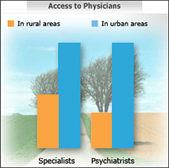An HIT Moment with … Alberto Borges
An HIT Moment with ... is a quick interview with someone we find interesting. Al Borges, MD is an oncologist with Arlington Medical Group of Arlington, VA.
Can EMRs ever be efficient and helpful to doctors when much of what they do is document encounters for payment?
 The primary use of an EMR is as a card file or Rolodex to find patients. After that, their use is especially valuable for maintenance of a basic, concise clinical record (including PMH, SH, FH) and then to make great notes (SOAP notes, admission notes, consultation notes).
The primary use of an EMR is as a card file or Rolodex to find patients. After that, their use is especially valuable for maintenance of a basic, concise clinical record (including PMH, SH, FH) and then to make great notes (SOAP notes, admission notes, consultation notes).
As you’ve stated, EMR systems are also the basis of most practice management systems (“PMS”) to document an encounter. The use of boilerplate templates is invaluable to make sure that all the necessary items are present for billing the appropriate CPT code level of treatment.
What are some of the other healthcare technology tools you use in your practice, in addition to the EMR?
Google is the first one that comes to mind. I use that for billing (i.e. search for “ICD code melanoma”), for putting together a quick patient handout for an illness, for looking up oncology research protocols, to get medical information (in particular, eMedicine and Medscape are useful sites), for translations (especially English to Spanish), and to get pictures to show patients (Google-> Images).
I also use Dragon Naturally Speaking Standard/Preferred quite a bit. For pulmonary function tests, I use a PC software that works in conjunction with a USB hardware for patients to blow into. (Eventually I’ll also be using a PC EKG, too.) I use MS Access not only for my EMR, but for my practice management system and for chemotherapy. I use MS Works for its calendar feature that can group entries — very helpful for seeing when a particular patient needs more chemotherapy.
The recent proposals in Congress are tying stimulus money the purchase of certified products. Do you think that will eventually mean the end of non-certified products?
No. Check out this quote from a recent CDC report on 10/2007:
“The use of EHR systems in physician offices and medical practices increased significantly in 2006, however, the adoption rate of ‘comprehensive’ EHR systems remained statistically unchanged”
HIMSS may have convinced Congress to go along with CCHIT. What has happened is that they should have tried to convince physicians, who without their participation, CCHIT will not be able to survive. Three facts:
- Doctors don’t generally want to buy into expensive CCHIT-certified EHRs which offer little to no return on investment.
- Doctors don’t generally want to use difficult to understand systems that are associated with high failed installation and de-installation rates.
- Doctors despise the idea of further unfunded mandates and will avoid any products associated with what is perceived to be as political albatrosses that are unneeded and unnecessary.
This is what makes my job as an anti-CCHIT blogger relatively easy — I simply post factual statements aimed at physician potential buyers. HIMSS/EHRVA may have millions of dollars to throw at promoting, lobbying, and advertising for CCHIT, but unless they can win the hearts and minds of end users, they don’t stand a chance at forcing their agenda through successfully.
If you were the government and had visions of a high quality, low cost, interconnected healthcare system, what technology would you recommend or create to meet those goals?
First of all, we have to define “quality”. It used to be based on Board certification, on word-of-mouth by patients who have experienced good outcomes, and on peer review (i.e. physicians send patients to qualified fellow physicians). Occasionally, patients put up with slightly less quality for a better deal (think HMO). Now big government and health insurance companies want to pay as little as possible and to use technology to somehow increase/ensure “quality”.
Now to do this, they have to show studies which have demonstrated quality as well as show that these systems can save money, which neither of which have been proven. On top of that, they want physicians to purchase technology at a very high cost both in terms of money, time, and effort with no expectation of ROI. Now you have President Obama, who wants to force through HIT in less than four years, when this process should go through slow, small steps as the evidence of its value increases.
I feel that big government, if they wish to do anything at all, should focus on the basics, i.e. set up the RHIOs to collect patient data and to provide a way to interconnect computer systems. They should put together an easy way for any EMR to communicate, either through an XML-based CCR record, or through an ODBC-like interface between database systems. The emphasis should be “free” (or very low cost) and “easy”. Let physicians pick the actual low-cost EMR system that best suits their practice patterns and documentation needs, such as keyboarding/boilerplate templates, handwriting recognition, or dictation.
You are a regular contributor to sites like Sermo, EMRupdate, and even HIStalk. How do you think sites like these and newer social networking sites will impact healthcare over time?
I firmly believe that blog site discussions have had an enormous impact on counter-punching the HIMSS lobbying efforts and will derail any poorly thought out mandates as readers become better informed consumers. I personally have seen a drastic change in the way that e-prescribing, CCHIT certification, and pay-for-performance are viewed in just the past two years. Mention these topics in a positive light in any physician Web site nowadays and you get eaten alive.
In other websites like emrupdate and at HIStalk, where physicians constitute a minority of posters, readers have usually been more open-minded about these things, but even these folks are starting to question the negative impact of these mandates on competition and growth of HIT. Just do a Google search now for “CCHIT” and you will rarely see a positive review outside of the HIMSS Web site.






Re: Walmart Health: Just had a great dental visit this morning, which was preceded by helpful reminders from Epic, and…